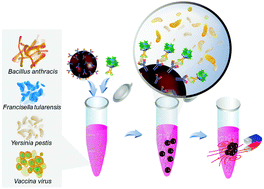Engineered nanoconstructs for the multiplexed and sensitive detection of high-risk pathogens
Abstract
Many countries categorize the causative agents of severe infectious diseases as high-risk pathogens. Given their extreme infectivity and potential to be used as biological weapons, a rapid and sensitive method for detection of high-risk pathogens (e.g., Bacillus anthracis, Francisella tularensis, Yersinia pestis, and Vaccinia virus) is highly desirable. Here, we report the construction of a novel detection platform comprising two units: (1) magnetic beads separately conjugated with multiple capturing antibodies against four different high-risk pathogens for simple and rapid isolation, and (2) genetically engineered apoferritin nanoparticles conjugated with multiple quantum dots and detection antibodies against four different high-risk pathogens for signal amplification. For each high-risk pathogen, we demonstrated at least 10-fold increase in sensitivity compared to traditional lateral flow devices that utilize enzyme-based detection methods. Multiplexed detection of high-risk pathogens in a sample was also successful by using the nanoconstructs harboring the dye molecules with fluorescence at different wavelengths. We ultimately envision the use of this novel nanoprobe detection platform in future applications that require highly sensitive on-site detection of high-risk pathogens.

- This article is part of the themed collection: Coronavirus articles - free to access collection


 Please wait while we load your content...
Please wait while we load your content...